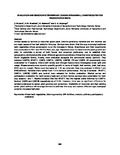Evaluation and selection of spiderplant (Cleome gynandra L.) varieties suited for production in kenya

View/
Date
2013Author
Mutoro, K
Masinde, PW
Kebwaro, D
Onyango, CA
Metadata
Show full item recordAbstract
Limited access by farmers to improved spider plant (Cleome gynandra) varieties and low fertilizer use are major causes of low leaf yields for this crop. Surveys have shown that the crop is among traditional leafy vegetables whose consumption is on the increase in Kenya. Greenhouse and field experiments were conducted in 2011 and 2012 in Ruiru and Juja. Objectives were: to determine the plant growth and yield; to undertake a survey of both farmer and consumer preference; and to establish their comparative nutritional profile under different agronomic conditions. 8 lines that were developed at the World Vegetable Centre, Arusha, were evaluated alongside the commercial variety (control). They included UGSF25, MLSF17, UGSF3, UGSF14, UGSF25, UGSF36, IP3 and UGSF9. All experiments were undertaken for 2 seasons, where both variety and nitrogen factors were investigated under split–plot design. Measurements were done to quantify growth in terms of height, leaf number, yield, leaf area, SPAD and dry weight. Plants were harvested at 7-10 day intervals. Data was analysed in SAS 9.1 and SPSS software. Varieties were ranked from 1-9 in terms of performance. The top 5 varieties - MLSF17, UGSF14, UGSF36, UGSF9 and control were selected for further evaluation. Market survey and
participatory evaluation for both sensory tests and on-farm farmer surveys were undertaken for both crop seasons I and II. Results indicated that line MLSF17 had the highest yields followed by UGSF14, Control, UGSF9 and UGSF36 respectively at p ≤ 0.05. However, there was no significant difference for varietal preference by spider plant growers and consumers. Availability of improved and high yielding spider plant cultivars will leverage farmers to cultivate this crop and explore different agro ecological zones for increased leaf yield.
